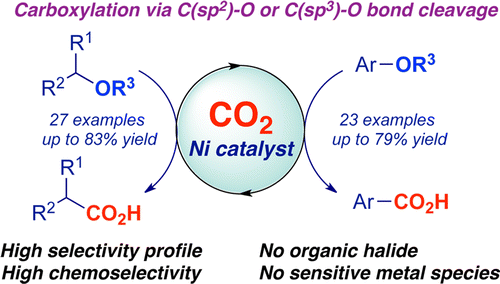In recent years a significant progress has been made for the carboxylation of aryl and benzyl halides with CO2, becoming convenient alternatives to the use of stoichiometric amounts of well-defined metal species. Still, however, most of these processes require the use of pyrophoric and air-sensitive reagents and the current methods are mostly restricted to organic halides. Therefore, the discovery of a mild, operationally simple alternate carboxylation that occurs with a wide substrate scope employing readily available coupling partners will be highly desirable. Herein, we report a new protocol that deals with the development of a synergistic activation of CO2 and a rather challenging activation of inert C(sp2)–O and C(sp3)–O bonds derived from simple and cheap alcohols, a previously unrecognized opportunity in this field. This unprecedented carboxylation event is characterized by its simplicity, mild reaction conditions, remarkable selectivity pattern and an excellent chemoselectivity profile using air-, moisture-insensitive and easy-to-handle nickel precatalysts. Our results render our method a powerful alternative, practicality and novelty aside, to commonly used organic halides as counterparts in carboxylation protocols. Furthermore, this study shows, for the first time, that traceless directing groups allow for the reductive coupling of substrates without extended π-systems, a typical requisite in many C–O bond-cleavage reactions. Taking into consideration the limited knowledge in catalytic carboxylative reductive events, and the prospective impact of providing a new tool for accessing valuable carboxylic acids, we believe this work opens up new vistas and allows new tactics in reductive coupling events.
